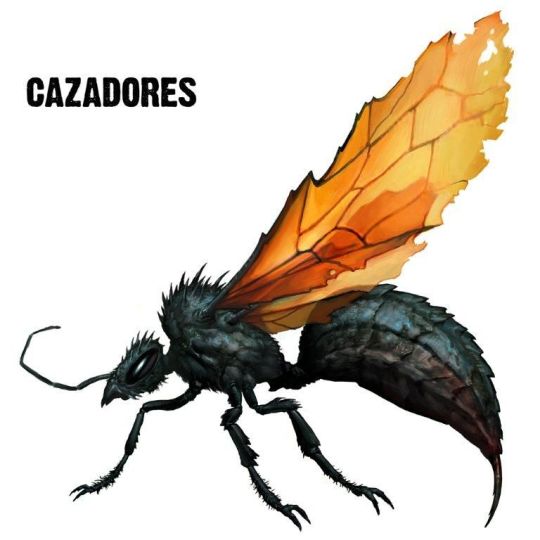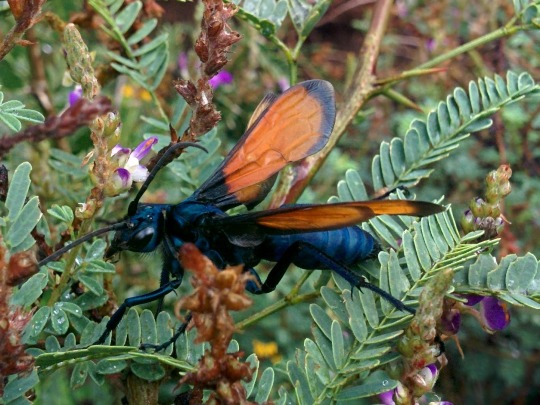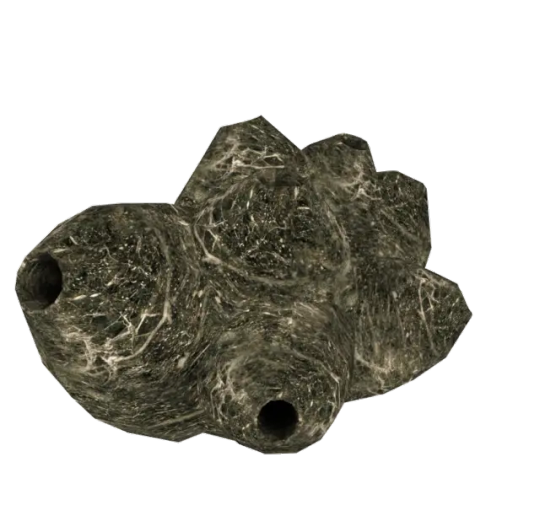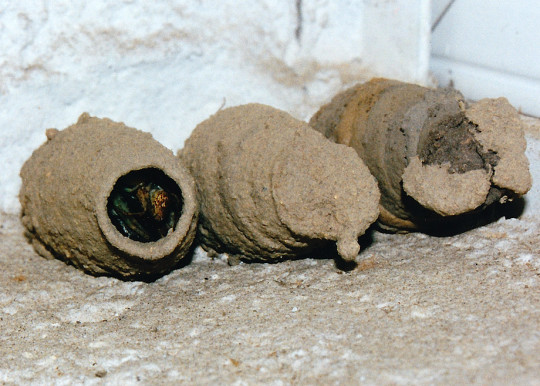#eusocial insects
Text
More types of bugs ought to be eusocial I think. It would be very cool.
I want to see what it would be like for mosquitos to try to store blood like bees store honey. I want to see swarms of lightningbugs as they leave to make a new nest. I want to see what a queen butterfly looks like.
12 notes
·
View notes
Text
instagram

I couldn't copy the text on Mobile (fuck Instagram), but this is really cool!
#not tagged#ants#ant#hymenoptera#insect#bug#friend shaped#amputation#amputation tw#graphic imagery#eusociality#eusocial insects#personal#injury tw#infection tw#Instagram
2 notes
·
View notes
Text
Yay I love yellowjackets they are my favorite insect in the whole entire world yes I love them

8 notes
·
View notes
Text
i love parasites so much. they are like the evolutionary biological equivalent of those minerals people find in the earth that are fantastical shapes and colors in terms of awe factor to me
71 notes
·
View notes
Text

Insect eusociality?!
(Power Girl #7)
#power girl#Kara zor l#paige stetler#insect eusociality#huh#ferimbia#Leah Williams#marguerite sauvage#dc comics#comics#2020s comics#supergirl#kara zor el
13 notes
·
View notes
Text
DARPA asked for proposals for insect-based AIs. Bug furries/monsterfuckers and robofuckers need to unite to completely sexualize this concept before they make it work
#CMON! YOU CAN DO IT!!#I'VE SEEN WHAT YOU PEOPLE DO WITH MILITARY ROBOTS!#AND I'VE SEEN WHAT YOU PEOPLE DO WITH EUSOCIAL INSECTS!#andi'dliketoseemoreplease#robotfucker#robophilia#monsterfucker#shitpost#geeeeeeeeh i have so much on my plate i dont wanna do it myself....
20 notes
·
View notes
Text
#2176 - Polistes humilis ssp. humilis - Southern Australian Paper Wasp

A species of Vespid found in the SE of Australia and which has, unfortunately, been introduced to northern New Zealand.
These wasps build paper nests as seen here under the awning of the picnic shelter, and have been known to re-utilize old nests. They're a eusocial wasp, and there are distinct behavioral differences between queens and workers, but the castes are anatomically identical. Like most social wasps, will defend the nest with their painful sting if they feel their sisters are threatened.
There are 11 different Polistes species found in Australia, and the Polistes humilis is the most common and widespread, although it and P. variablis can be difficult to tell apart and the latter has been considered a subspecies of humilis. The other recognised subspecies, P. humilis synoeus, can be found in Queensland and the SW of the continent.
The Rock, NSW
7 notes
·
View notes
Text
for the record, i don't consider animals who form serendipitous groups to capitalize on safety-in-numbers, such as schooling fish, group sociality. there needs to be a consistent, long-term in-group who are lived with by default, with recognition of individuals and interpersonal reputations (ie. the animals can recognize individuals and prefer some over the other due to past interactions with said individuals) imo...
#except for the eusocials i suppose#insects specifically? i don't know if mole-rats recognize each other on an individual level#they can't even recognize whether someone is in their group or not unless they all roll around in feces regularly to smell like the group#but i have seen NMRs fight outsiders even after rolling them around in their bedding to smell like the in-group#it probably wasn't enough time to gain the new smell and lose the old#they must at least recognize the queen
10 notes
·
View notes
Note
4 or 57 🦐
4. what are you looking forward to?
I did this already but it is a good exercise to think of more stuff I am looking forward to. I am looking forward to the newest enstars event because it's a shuffle with like 4 of my favorite characters and the costumes/aesthetic look f*cking amazing. The MV is releasing tonight but I probably shouldnt stay up to watch it, though i am considering it... Also next month I think there should be the final (?) update for puyo puzzle pop and I'm this close to just asking some leakers to give me the final stories so I can listen to them and get it over with 1kj23kj12kk21l231 I'm going crazy. ...Oh and I ordered some charms/stickers for my eventual shop opening so I'm excited for those to come in ;_; dreading opening my store properly a bit only because I am really not sure if my stuff will sell, but I've always wanted to do this and I hope it's successful
57. favourite animal(s)
All species of foxes with fennec and arctic foxes at the top... I have become very fond of deer lately for some reason, probably because of a few of my OCs, but no specific species. Honorable mentions: housecats, puffins, ducks, pomeranians, marbled polecats, common genets, wasps and ants, probably others I am forgetting because I am an animal enthusiast...
ask meme
#inquiries#surgeofcrimsonshouts#I love eusocial insects in general tbh because I think they are cool
2 notes
·
View notes
Text
currently writing an essay in which i just compared Josef Stalin to a queen tropical sweat bee
#wannable rambles#don’t take an evolutionary biology class and a soviet lit class together#your brain cooks up some weird stuff#i will be turning this into my teacher tonight.#it will have to be peer reviewed but i’m really hoping they let me keep my soviet references#otherwise i might go even more insane#college#socialism#eusociality#ants#bees#insects#the word for animals that make colonies is called eusocial btw#it’s really cool#stalin#russia#ussr
3 notes
·
View notes
Text
im currently lost in the sauce imagining other animal groups evolving eusociality, how are you doing
#i just think more things than just bugs and naked mole rats should get to be eusocial#fucked! up! biological! castes!#come on we can get more mammals in there right#some reptiles#other groups of insects. lepidoptera could be Interesting#birds. especially birds.#i think some hummingbirds should become eusocial like truly go all the way to insects#also give more things venom. while we're at it.#(i know shrimps can also be eusocial im counting them as bugs)
2 notes
·
View notes
Text
realised i'd forgotten a word for 'family', went to add it in
then i thought, hang on, do i actually need it?
see,,, if u mean nuclear family, then 'household' is probably it. if u mean 'extended family', then 'community' is probably it.
don't need anything to imply blood relations in a community bc that's gonna be most people lmao. beyond that, motherlineage and clan account for what's left.
#theyre not quite like eusocial insects but close enough haha#kel dor conlang#social organization for them places little importance on genetic kinship#if u can work together to survive that's all that matters
3 notes
·
View notes
Text
Original caption: "I think we need both Bug's Life and Bee Movie updates what we now know about social insects #antcolony #antlife #buglife"
1 note
·
View note
Note
Always assumed termites had the same haplodiploid arrangement as ants and only now I am discovering that they are much, much weirder
YEAH the weird about Termites is that they are entirely unrelated to ants, bees, and wasps (termites evolved from cockroaches). Unlike other famous eusocial insects , they have a 50/50 split in sexes and hatch as nymphs instead of larva which makes their life cycles a lot..different



I’ve been looking at the (varied) graphs for termite lifecycle and caste development and it’s bizzare
#digimon like metamorphosis#termites also have kings that live with their queens instead of fuck n die
524 notes
·
View notes
Text
increasingly, I suspect that the average US citizen's political consciousness is somewhere above "eusocial insect" but somewhere below "particularly incurious medieval serf"
167 notes
·
View notes
Text
WASP REVIEW - CAZADORES (FALLOUT: NEW VEGAS)


[Image IDs: Two images of the Cazadores from Fallout: New Vegas, one being a render of the in-game model and the other being an official illustration /End IDs.]
This one's an interesting one! While the vast majority of fictional (non-ant/bee) wasps are based on Vespids such as the paper wasps, yellowjackets, or hornets, the Cazadores of the Fallout universe are based on spider wasps (Pompilidae), more specifically the genus Pepsis, one of two genera of tarantula hawk wasps (the other being Hemipepsis), a set of species that is, in fact, found in the deserts of the southwestern US, in which New Vegas is set.

[Image Source: Wikimedia Commons, Niklas299 | Image ID: A photo of an almost blueish black tarantula hawk wasp with orange and black wings, Pepsis grossa, on a leafy green plant /End IDs.]
They share many of the most famous features of these insects, such as their black coloration, curled antennae (in females, the opposite of paper wasps, whose males are the ones with curls), orange wings (although some species of the aforementioned genera have entirely black wings), and a similar body shape. These wasps also have some features, however, that don't match up with their inspiration, such as their red eyes (in-game), jagged wing shape, and much more pronounced setae (hair/fur), perhaps being adaptations brought on by the extreme radiation of the wastelands, or instead by something else entirely, which we'll be getting to later in this review.
They also have another key difference from their inspiration! Real world spider wasps are solitary and will either create or reuse existing underground burrows, whereas the Cazadores are eusocial! They create basket shaped nests out of an indeterminate material, very similar to the paper nest building hornets or tree-dwelling yellowjackets, but with multiple cells that have individual baskets and entrances, like that of a mud dauber nest.



[Image Sources: Ohio State University, Joe Boggs and Brisbane Insects | Image IDs: Three images, including one render of the Cazadores nest, and two photos of real world nests, those being the paper nest of the bald-faced hornet (actually a type of yellowjacket) and the mud nest of the vase-cell mud dauber /End IDs.]
"Well, why?" is what I asked when I first heard that this solitary wasp was suddenly eusocial, something that's not easily explained even by heavy amounts of fictionalized mutation-inducing radiation. Well, this may be best explained by the work of our resident brain-in-a-jar Think Tank robot, Doctor Borous. His work in the Z-14 Pepsinae DNA Splicing Lab of Big MT is what directly lead to the creation of the Cazadores, potentially having been spliced with the aforementioned hornets, yellowjackets, mud daubers, and possibly many more species, permanently altering their DNA and behaviors!
The idea of this is fairly fantastical, but highly likely in this universe, given Borous' other experiments, which lead to the creation of the Nightstalker, a mix of rattlesnake and coyote DNA.
Doctor Borous himself, meanwhile, seems completely unaware of his creation's prevalence throughout the wastelands of New Vegas' Mojave, content to deny their existence elsewhere and even their ability to reproduce. This fact, of course, is easily proven through the multitude of individuals you find throughout the desert and the eggs you might find alongside them.

[Image ID: A render of the model of a Cazador egg /End ID.]
Our good Doctor claims to have castrated the individuals he had in captivity within the research lab, but this only further goes to show his confident incompetence, implying he either: Heavily botched the procedure, or outright neglected to do so to female specimens.
You may think that these wasps would be incapable of reproducing, should the males be successfully castrated, however, a female wasp can still produce an unfertilized egg. This unfertilized egg, in Hymenoptera, will always contain a male, making it that much more likely to be able to reproduce with the females of its kind, creating fertilized (female) eggs, and thus the cycle continues until you have a desert full of wasps!
Finally, as for their defense techniques, Cazadores seem pretty standard for eusocial wasps, attacking potential threats to the hive when they get too close with repeated stings from multiple individuals, while having a notably higher than normal level of aggression (I would too if I was created by a supremely incompetent yet skilled mad scientist and/or floating brain like Doctor Borous). I have to wonder what their hunting techniques are, and what they go for as well. The adults would presumably still feed on nectar, but, being such large insects, might need to turn things up a notch in terms of what they collect for their young... A tasty radscorpion, perhaps?
In any case, I actually don't doubt a genetically engineered superwasp's ability to incapacitate or kill a human in a few stings, with such a large stinger doing massive mechanical damage to the skin and possibly the internal organs and presumably scaled up venom built to deal with larger creatures!
In conclusion, the Cazadores are fascinating creatures, and, while not entirely accurate to their original inspiration, New Vegas does a fantastic job making them make sense within the world they created, inaccuracies and all, clearly putting some thought into these creatures! Plus I quite appreciate the more unique and fitting choice of inspiration.
-
Overall: 8/10
-
This wasp review was suggested by @cupidtheartsy ! Leave your wasp review suggestion in the replies, tags, or askbox!
Make sure to tune in next week when we cover the Zingers from the Donkey Kong series!
221 notes
·
View notes